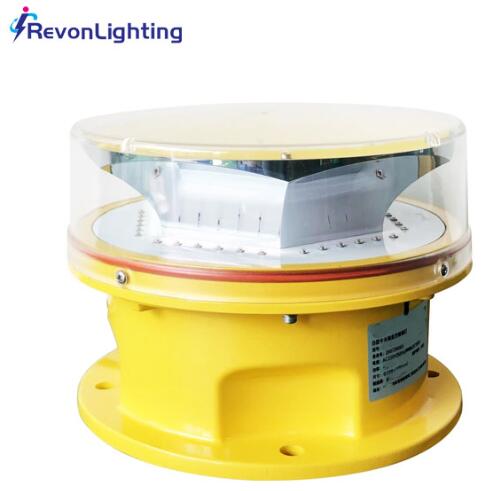Posted: 2024-06-20
Medium intensity aviation obstruction lights are critical components in maintaining safe navigation for aircraft. These lights are designed to mark obstacles that pose a threat to aviation, such as tall buildings, communication towers, wind turbines, and other structures. This article delves into the importance of medium intensity aviation obstruction lights, their specifications, applications, regulatory standards, technological advancements, and future trends.
Understanding Medium Intensity Aviation Obstruction Lights
Definition and Purpose
C are lighting devices that mark obstacles to alert pilots during both day and night operations. They are used for structures between 45 meters (approximately 150 feet) and 150 meters (approximately 500 feet) in height. These lights ensure that obstacles are visible to pilots, thereby preventing collisions and enhancing overall flight safety.
Categories and Specifications
Medium intensity obstruction lights are classified into different types based on their intensity and application:
Type A: These lights emit a flashing white light with an intensity of 20,000 candelas during the day and 2,000 candelas at night. They are used in areas with high ambient light levels where greater visibility is required.
Type B: These lights also emit a flashing white light but with lower intensities—2,000 candelas during the day and 2,000 candelas at night. They are typically used in less densely populated areas.
Type C: These lights emit a steady red light with an intensity of 2,000 candelas at night. They are used in areas where flashing lights are not suitable or where red lights are preferred due to environmental considerations.

Applications of Medium Intensity Aviation Obstruction Lights
Urban Infrastructure
In urban environments, medium intensity obstruction lights are used on tall buildings, bridges, and other structures to ensure they are visible to aircraft. This is particularly important in cities with high-rise buildings where the risk of collision is greater due to the density of tall structures.
Telecommunications and Broadcasting
Medium intensity lights are essential for marking communication and broadcasting towers, which are often located on hilltops or other elevated areas. These towers can reach significant heights, making them potential hazards for low-flying aircraft.
| medium intensity obstruction lights | TYPE A |
| TYPE B | TYPE C |
| TYPE A/B | L-864 |
Wind Farms
Wind turbines, especially those in large wind farms, require medium intensity obstruction lights to mark their presence. These lights help pilots navigate around the turbines, particularly in remote areas or offshore locations where wind farms are commonly situated.
Airports and Heliports
Medium intensity obstruction lights are used to mark various structures around airports and heliports, including control towers, hangars, and maintenance facilities. These lights help pilots identify and avoid these structures during takeoff, landing, and taxiing operations.
Regulatory Standards and Guidelines
International Standards
The International Civil Aviation Organization (ICAO) provides comprehensive guidelines for the use of obstruction lights to ensure global uniformity and safety. ICAO Annex 14 outlines the requirements for the intensity, color, and flash rates of these lights to ensure they are effective in different environments and conditions.
National Regulations
Individual countries have their own regulations governing the use of medium intensity obstruction lights. For instance, the Federal Aviation Administration (FAA) in the United States specifies detailed requirements for the installation, operation, and maintenance of these lights to ensure they meet safety standards.
Compliance and Maintenance
Ensuring continuous compliance with regulatory standards requires regular maintenance and inspections of medium intensity obstruction lights. This includes verifying proper operation, cleaning lenses, and replacing faulty lights. Automated monitoring systems can alert operators to any issues, ensuring timely maintenance and reducing the risk of failures.
Technological Advancements
LED Technology
The adoption of LED technology in medium intensity obstruction lights has revolutionized the field. LEDs offer numerous advantages, including lower power consumption, longer lifespan, and reduced maintenance needs compared to traditional incandescent or halogen lights. Additionally, LEDs provide consistent light output and are more environmentally friendly.
Solar-Powered Lights
Solar-powered medium intensity obstruction lights are increasingly popular, especially in remote or off-grid locations. These lights use photovoltaic panels to capture solar energy, which is stored in batteries for use during low-light conditions. Solar-powered lights reduce dependency on external power sources and contribute to environmental sustainability.
Intelligent Lighting Systems
Advancements in intelligent lighting systems incorporate sensors and control mechanisms to optimize the operation of medium intensity obstruction lights. These systems can adjust light intensity based on ambient conditions, detect faults, and communicate with maintenance teams for proactive servicing. Integration with aviation safety systems ensures these lights provide maximum benefit while minimizing energy consumption.
Future Trends
Enhanced Integration with Air Traffic Control Systems
Future developments are likely to see medium intensity obstruction lights becoming more integrated with air traffic control (ATC) systems. This integration would allow for real-time monitoring and management of obstruction lights, improving safety and operational efficiency. Enhanced communication between ATC and obstruction lights can help in dynamically managing lighting based on current flight paths and weather conditions.
Advanced Materials and Designs
Research and development in advanced materials and designs are expected to produce more robust and efficient medium intensity obstruction lights. Innovations such as self-cleaning lenses, weather-resistant materials, and more efficient optical designs will further reduce maintenance requirements and enhance the reliability of these lights.
Increased Use of Renewable Energy
As the world shifts towards sustainable energy solutions, the use of renewable energy sources for medium intensity obstruction lights is expected to grow. This trend will reduce the environmental impact of these lights and facilitate their deployment in remote and environmentally sensitive areas.
Conclusion
Medium intensity aviation obstruction lights play a vital role in ensuring the safety of aviation by marking potential hazards and enhancing the visibility of obstacles. With ongoing advancements in technology and increasing emphasis on sustainability, these lights are becoming more efficient, reliable, and environmentally friendly. Adhering to regulatory standards and leveraging new technologies will continue to enhance the safety and efficiency of medium intensity obstruction lights, making our skies safer for all.